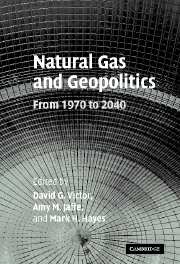Book contents
- Frontmatter
- Contents
- List of figures
- List of tables
- List of boxes
- List of contributors
- Foreword by James A. Baker, III
- Acknowledgments
- List of acronyms and abbreviations
- Part I Introduction and context
- Part II Historical case studies
- 2 Introduction to the historical case studies: research questions, methods and case selection
- 3 The Transmed and Maghreb projects: gas to Europe from North Africa
- 4 Liquefied natural gas from Indonesia: the Arun project
- 5 Bypassing Ukraine: exporting Russian gas to Poland and Germany
- 6 Natural gas pipelines in the Southern Cone
- 7 International gas trade in Central Asia: Turkmenistan, Iran, Russia, and Afghanistan
- 8 Liquefied natural gas from Qatar: the Qatargas project
- 9 Liquefied natural gas from Trinidad & Tobago: the Atlantic LNG project
- 10 Politics, markets, and the shift to gas: insights from the seven historical case studies
- Part III International gas trade economics
- Part IV Implications
- Appendix: Technical notes
- Index
- References
5 - Bypassing Ukraine: exporting Russian gas to Poland and Germany
Published online by Cambridge University Press: 22 September 2009
- Frontmatter
- Contents
- List of figures
- List of tables
- List of boxes
- List of contributors
- Foreword by James A. Baker, III
- Acknowledgments
- List of acronyms and abbreviations
- Part I Introduction and context
- Part II Historical case studies
- 2 Introduction to the historical case studies: research questions, methods and case selection
- 3 The Transmed and Maghreb projects: gas to Europe from North Africa
- 4 Liquefied natural gas from Indonesia: the Arun project
- 5 Bypassing Ukraine: exporting Russian gas to Poland and Germany
- 6 Natural gas pipelines in the Southern Cone
- 7 International gas trade in Central Asia: Turkmenistan, Iran, Russia, and Afghanistan
- 8 Liquefied natural gas from Qatar: the Qatargas project
- 9 Liquefied natural gas from Trinidad & Tobago: the Atlantic LNG project
- 10 Politics, markets, and the shift to gas: insights from the seven historical case studies
- Part III International gas trade economics
- Part IV Implications
- Appendix: Technical notes
- Index
- References
Summary
Introduction
In the early 1990s the giant Soviet enterprise of Gazprom began work on a new project to export gas across Belarus to Poland and Germany. Close examination of this project offers crucial insights into the potential for Russia's future gas exports because it was the first (and so far only) large new Russian gas pipeline project constructed after the dissolution of the Soviet bloc of nations (the Council for Mutual Economic Assistance, CMEA, also known as COMECON) and the Soviet Union itself. The Russian government envisions that total gas exports to Western Europe will rise to 200 (Bcm) per year by 2020 (up from more than 130 Bcm in 2005); whether, and how, such ambitions are realized depends on the practical experiences with this project – the first constructed in an era where markets have played a larger role than state-controlled financing in determining the size and route of pipelines.
This project remains the single largest expansion of gas transmission through Belarus. Whereas nearly all Russian gas exports to Western Europe traveled through Ukraine (and still do today), by the mid-1990s theft and risk of interruption of gas during Ukrainian transit had focused Russian minds on finding alternative routes. Finally, although this project was mainly conceived to serve the German market, it also was pursued partly with the aim of supplying the largely virgin gas market in Poland.
- Type
- Chapter
- Information
- Natural Gas and GeopoliticsFrom 1970 to 2040, pp. 122 - 168Publisher: Cambridge University PressPrint publication year: 2006
References
- 4
- Cited by



